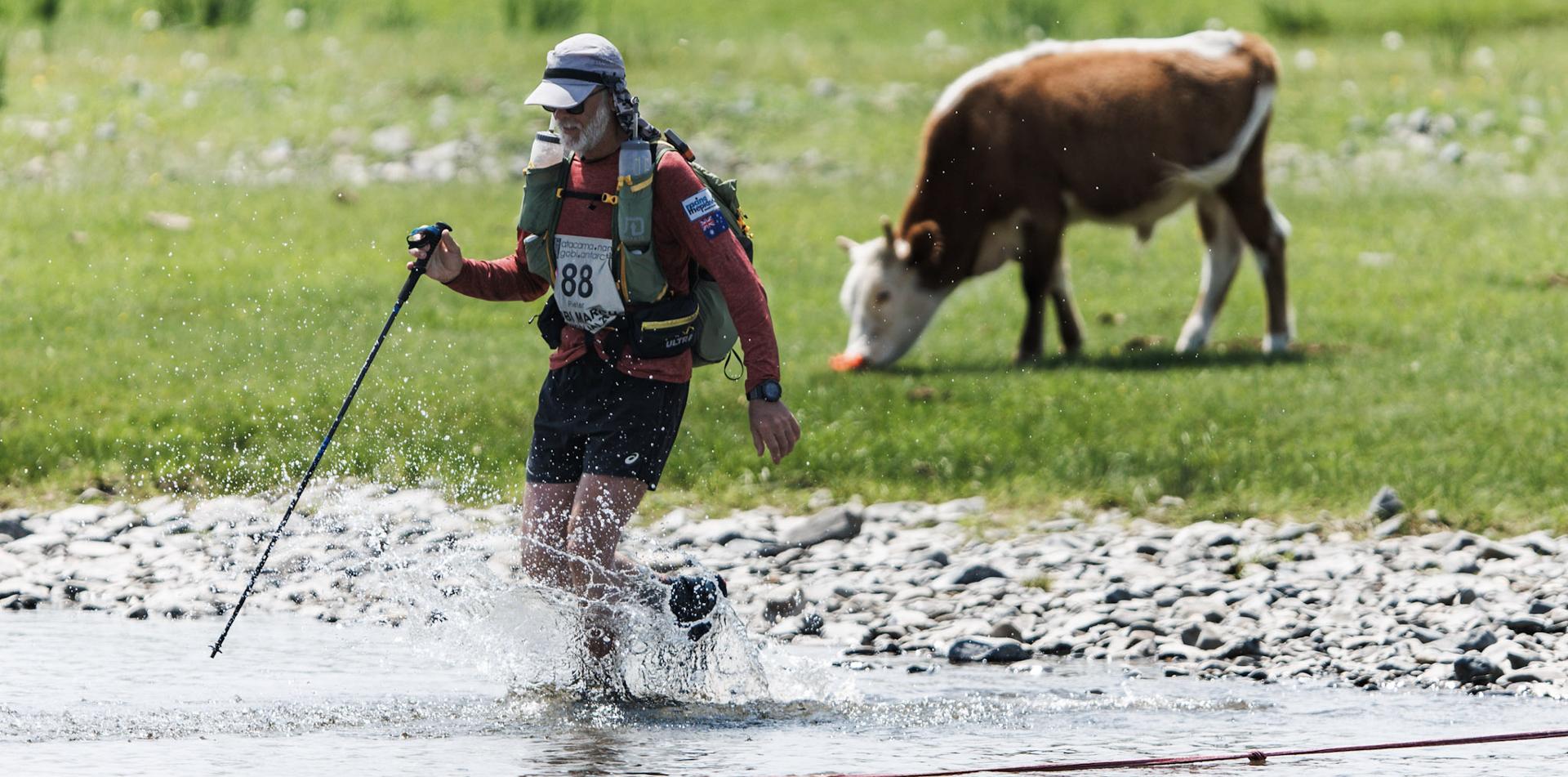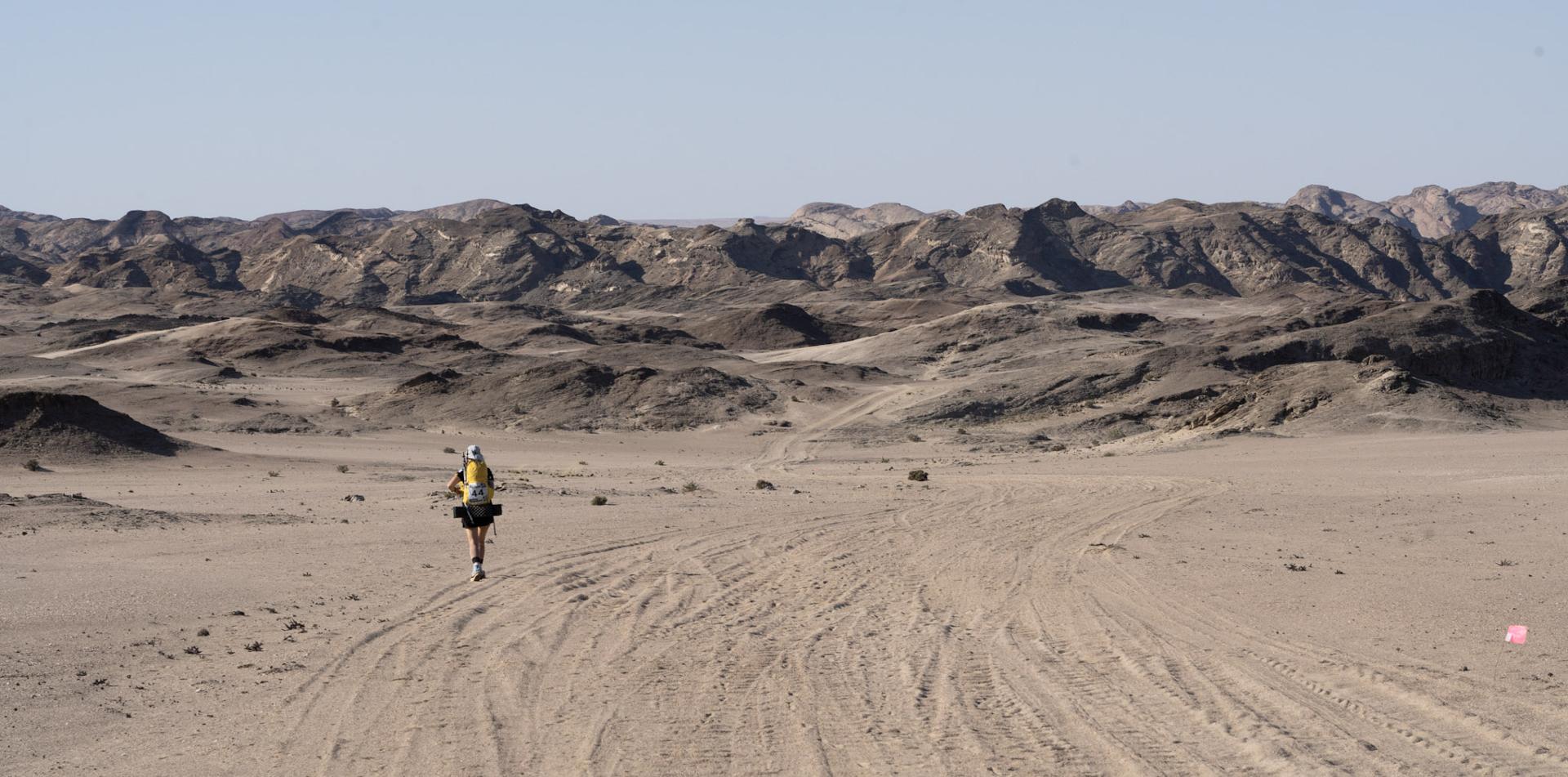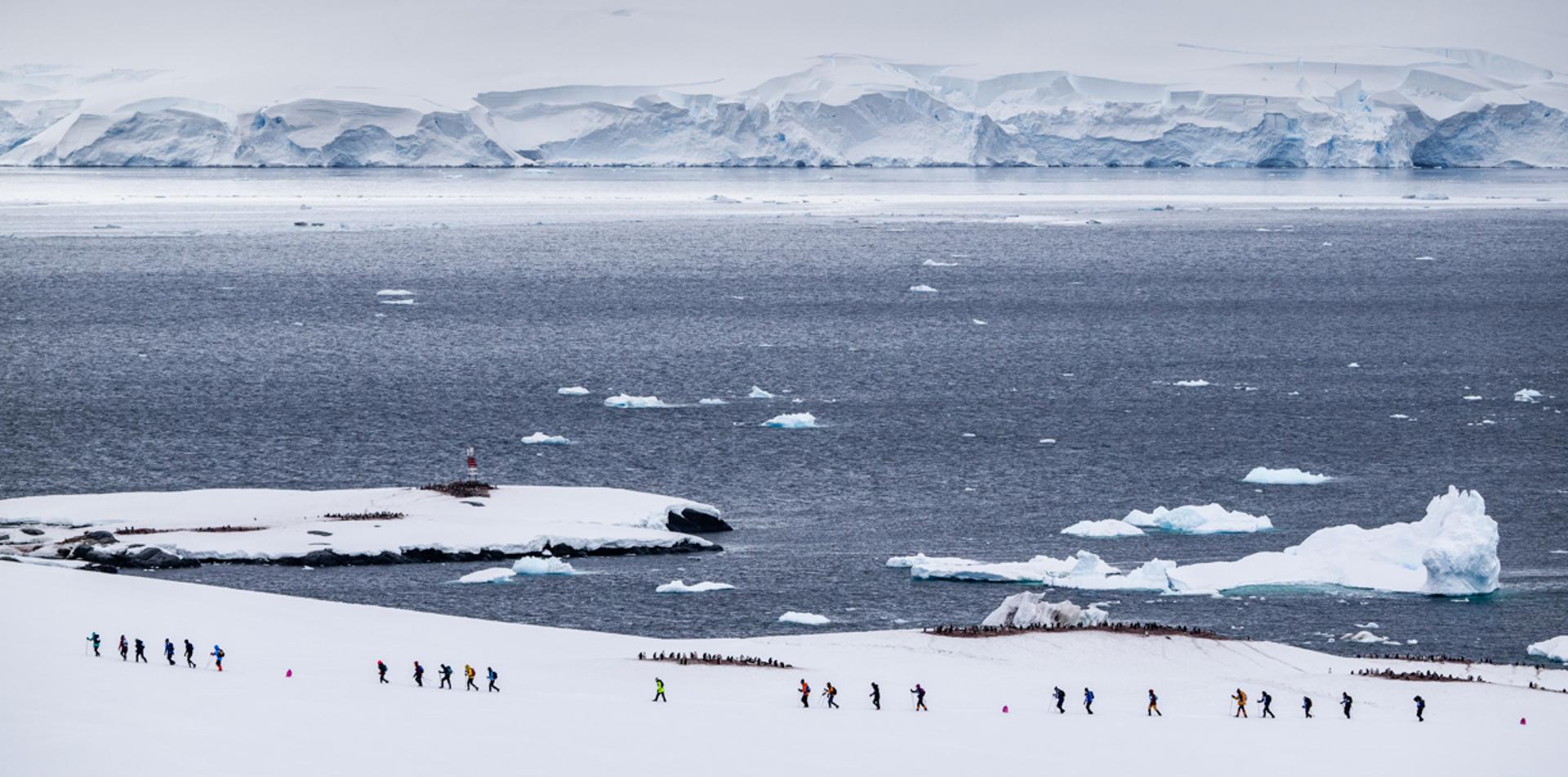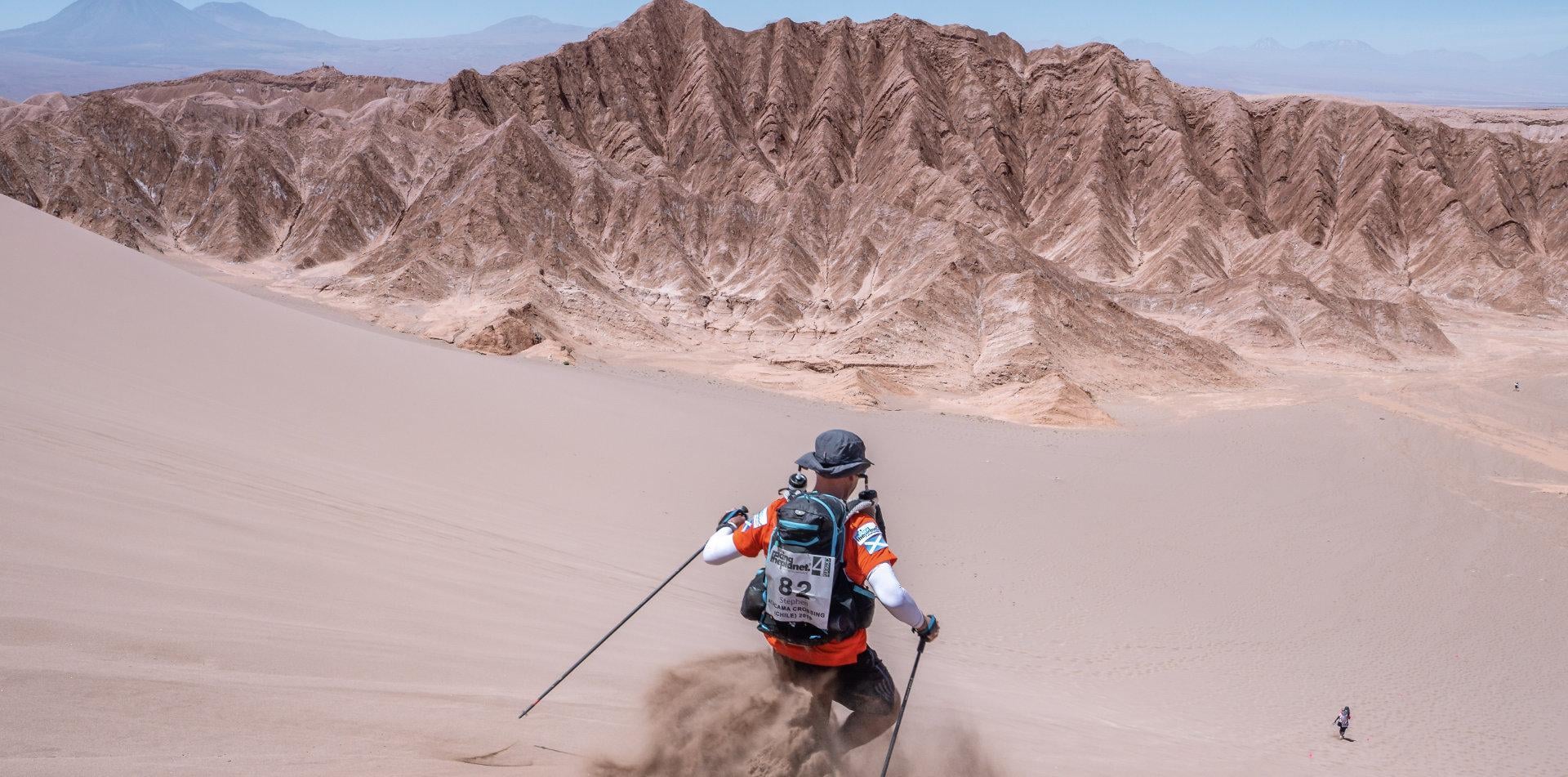Gobi March: a 250km walk in the Mongolian desert
By Giuseppe Didonna (Italy)
A race that for the first time this year took place in the Mongolian territory of the Gobi desert. 6 stages, which you participate in self-sufficiency, with everything necessary for the crossing in a backpack.
The organization provides participants with tents and water, even hot. All the rest, starting from a very long list of compulsory equipment, is carried in a backpack whose weight can vary from 7 to 12 kilos, depending on the 'preparation', which constitutes the first step for the athletes to take. In fact, the weight of the backpack represents the first factor intended to determine the progress of the race.
The event is organized by RacingThePlanet, an organization that runs races in 4 different deserts. In addition to the Gobi desert, the Namib desert of Namibia, the Atacama desert in Chile and Antarctica. Whoever completes the series of 4 enters the '4 Deserts Club.’
Considering that these are deserts I can say that for me that club remains a mirage. After many mountain running races, some of which were longer than 100 km, it was in fact my first desert, but above all my first stage race to be done running and marching with a backpack. Personally, I chose to participate in the Gobi March because this desert has always exerted an enormous fascination on me. At the same time this race was the event around which I launched a fundraiser for some mountain villages destroyed by the earthquake that hit Turkey last February.
Compared to the ultra trail races I held in the past, it was still a leap in the dark. You can run a hundred kilometers knowing that at the end of the day you will have a shower and a good meal, knowing that every 10-15 km there will be a check point with drinks and food that make it unnecessary to carry a heavy backpack. Impossible to train the lack of a shower and rationed food, in the last three months I've been preparing for the Gobi March running with weights.
If that would have been enough, I would have only found out it in Mongolia.
Before the race.
The day before the race is the day of the technical meeting and equipment check. A necessary step if you want to get the bib number. After a presentation of the itinerary, the check-in of the requested material starts. Control passes through electrolytes, supplements and meals (freeze-dried) which must guarantee a certain amount of calories on a daily basis, for the entire duration of the competition.
My backpack weighs 8.6 kilos, it could have been worse, I think, and I'm finally ready to get on the bus which, after a 5-hour journey, leaves us in camp 1 in the middle of the desert, from where the race will start in the morning of the following day.

The evening before the race, the atmosphere is relaxed. At camp 1, they joke and get to know each other, a small show of Mongolian music and dance is the occasion that brings together all the participants a few meters from the start. At eight in the evening everyone is already in the tent, the 'experts' know well what awaits them, the rookies, like myself, have a head full of question marks.
Mine will be an almost sleepless night, spent tossing and turning in my sleeping bag, disturbing my very patient 4 tent mates, 3 Italians and one from Ticino.
Stage 1: the first 35kms, plateaus, mountains and the final swamp.
Doubts and question marks that remain until there is no more time to think, but only to run. And finally it begins. The stage is 35 kilometres, starting from the ruins of the fort of Khar Bulkh Balgas, seat of the Kitan until 1120, in the period known as 'of the five Dynasties'. The itinerary passes through valleys where elegant herds of Mongolian horses move and mopeds whiz by with shepherds on board. It is evident that over the years the two wheels have surpassed the four legs in the preferences of nomads. The yurts remain eternal, the typical circular nomad tents from which curious children and adults busy with livestock and cheese emerge who never fail to greet them smiling.
It would be interesting to know what they think of these foreigners who have come from who knows where and who today liven up the panorama they are used to.
The stage features only one long, long climb, which however opens the view onto a boundless panorama and ends in a long descent that paves the way towards the first finish line. I feel good and I'm also able to push in the last kilometres. The backpack does not weigh too much and I already feel the first finish line close. When this is already visible, however, the surprise arrives: a swampy marsh of mud and clay to cross in the last kilometre. If you don't want to sink up to your ankles or worse, the best thing is to jump on the clods of earth, hoping they hold. Those chosen by me hold almost all, because just when the swamp is about to end I choose the wrong clod and they end up ankle-deep in mud. I'll wash them the same evening, the race is long and limiting shirts, pants and underwear is one of the strategies to lighten the backpack.
Stage 2: 45kms, green valleys surrounded by rock pinnacles.
The second day includes a stage of 45 kilometers with more than a thousand meters of elevation gain. It starts flat, then begins a long climb up to a mountain pass. The climb ends and opens the way to a long descent, a series of very long false flats before three 'teeth', three climbs in the last 15 kilometers before the end of a stage that presents itself as one of the toughest. The valleys are green, rocky, dotted with huge herds of sheep and goats. Spectacular stone pinnacles rise up the sides of the path. I feel good, my legs hold up on the climbs, it's not too hot and when the fatigue and the weight of the backpack make themselves felt, the panorama takes care of distracting the mind until the end of the stage. It went well and in the general classification I am even in ninth place. I feel fit and I even think of aiming to enter the top 10. A goal destined to crash against the dunes the following day and the heat of the 80 km 'tapponè' that awaits us from there in 48 hours.

Stage 3: 40kms between mountains, monasteries and dunes.
At the end of the second stage, a night awaits us not in a tent, but in a traditional Mongolian yurt. A structure with a wooden skeleton that opens and closes like an accordion, held together by a complex system of knots which, however, "all Mongolians know how to assemble", as a local young man explains to me, looking at me as if I had done the stupidest of requests. Behind our yurts the mountain to be climbed tomorrow. A very steep ascent of approximately for the first two kilometers of a stage of 40 km in total. Two km in which more than 500 meters in altitude are concentrated. Then it's up to an equally steep descent between the rocks to a small and beautiful Buddhist temple. I pass by tapping the spinning bells hoping it bodes well. I keep running for a flat stretch, a wild camel nurses its two cubs while other enormous specimens bathe in a nearby lake. It will be the last body of water before entering the realm of the dunes.

Here is my collapse, a collapse from which I will never recover. I am dehydrated, suddenly the temperature has risen by 10 degrees. The route involves the ascent of several dunes, but I can't say how many due to the lack of lucidity at that moment. Very rapid climbs where you slip backwards with each step. Everyone slows down, not just me, someone stops in the shade of the only tree. My shoes are full of sand, I'm dehydrated but I can't drink, I'm constantly retching but I can't vomit. I have to get out of here, I think, but although it's just 6 kilometers in the dunes, it seems to go on forever. Returning to earth is a sigh of relief. Eagles and hawks circle above our heads, remains of carcasses emerge from the last sandy stretch, we're here now, one kilometer to go and the finish line appears at the last minute. I walk through it without knowing if it is a mirage. At my side a Korean and an American, also exhausted. We take a photo for a moment that we would never forget anyway.
Stage 4: The Long March, 80kms in the heat.
Stage races always include a 'tapponè', a very long stage in which 'anything can happen' and the classification can be subject to upheavals.
And that is what actually happens. The very strong Swiss, Reinhold Hugo, until then firmly leading the classification, gives in to the heat and collapses due to stomach problems. The American, Ken Rideout, a very popular podcaster and marathon runner who aims to set the over 50 record in the 5 most important marathons in the world, surpasses it and accumulates an advantage that will be decisive for the final result. Rideout had the merit not only of having battled with Hugo from the second day, but of assisting him when he had stomach issues and waiting by his side for the arrival of the jeep with the doctors.
A true example of the sportsmanship and empathy that distinguishes extreme trail competitions, in which participants know very well that the variables are out of control, every minimum detail is paid for and something can go wrong at any time for anyone, anyone excluding.
My 'tapponè' is instead a 15-hour day that I won't forget easily. After running the first 15km I started to give in to the heat. I first tried running 4 and walking a mile, a sequence repeated twice, before walking inexorably took over running. The temperature was close to 40 degrees, the ups and downs were continuous, the breeze on the top of the hills was pure oxygen, but from km 20 to the check point at km 50 for me every step will be a struggle with myself with my stomach always ready to rebel and reject everything, leaving me drained of fluids and energy. I arrive at the checkpoint at km 50, there is hot water here and I take the opportunity to sit down, hydrate and eat some freeze-dried potato purée. I dissolve a stock cube in hot water and I feel much better. I leave again, the sun goes down slowly and I complete the last 20 km of the stage running. I arrive at the finish line which is dark, behind the curtain the legendary Orkhon River. Without thinking about it, I go up to my knees, wash myself in the dark, raise my eyes and stop for a few moments to look at a sky in which there seems to be no room for one more star. I crawl into my sleeping bag, shattered, not having forcibly swallowed my 600 calories of freeze-dried food. More than a dinner it is a negotiation with my stomach which has been on its limit for more than 24 hours.
The day of rest.
The following day is the rest day. The latest arrivals of the 'tapponè arrive at the camp in the morning, when the sun has already risen. At the camp everyone takes advantage of the day to hydrate, swim in the river and eat. The doctors tent looks like a crowded city emergency room. The most frequent torment is blisters. I rest, wash my few belongings in the icy waters of the river under the eyes of huge flocks of sheep from which the precious Mongolian cashmere is produced and I try to drink as much as possible. The day is warm and sunny, but the Gobi is also famous for the sudden downpours of the weather and in the early afternoon, large clouds gather on the horizon. The storm is approaching and at a certain point lightning begins to strike a few kilometers from the camp. The organization decides to evacuate and let us get on the buses. About an hour passes, the alert disappears and you can go back to the tent. The air has freshened and tomorrow the battlefield of Genghis Khan awaits us.
Stage 5: 42kms, from the battlefield of Gengis Khan to an ‘Alpine’ Valley.
We start with the climate that does not bode well. "Until yesterday you were complaining about the heat, now it's fine, what are you complaining about?". is a phrase that I will repeat to myself for the first two and a half hours of the stage, as we cross a plain where the golden horde, Genghis Khan's army, conquered the victories that allowed them to lay the foundations for a empire which extended from Korea to Hungary and which came to touch the borders of Poland and Austria. Today the only horses that whiz by are the semi-wild ones of the nomads. It doesn't rain arrows, but cold rain and hail, cavalry attacks don't arrive, but gusts of wind that also make it difficult to go straight and in some moments even to stand. It is also difficult to keep your eyes open, but there is no there is a lot of choice and you have to keep going, lightning is getting closer and closer.
The sky begins to open up when 20 km have passed and we have forded 4 rivers in the pouring rain. It would have been nice to have the fords yesterday, in the drought, but even thinking about it is a waste of energy that we cannot afford at this point. I have inflammation of the sciatic nerve in my left leg, I ask the doctor for something and he gives me an ointment. But ointments only work for those who believe in them and I'm not one of them.
The sky opens up, a meadow opens up which, among yurts, horses, curious shepherds and playing children, gradually climbs into the greenery up to a forest of conifers. A panorama that recalls the Alps and that one would never expect in Mongolia. It begins a long climb between huge trees to a pass from which you can only descend. I can't push and I have pain with every step, I reach the checkpoint at the thirtieth kilometer and ask the doctor for a painkiller. I swallow the pill and immediately feel better. I finish the stage at a good pace. As I ford the last river before the finish line, with water up to my knees I think that the Gobi March is now conquered, with some regret because I feel that I could have done better, but the experience gained is worth gold for the future.
Last stage: 10kms to the monastery, winners and participants.
The last 10 kilometres, from the field up to the great Buddhist monastery of Derren Zu, at least in theory, a celebratory parade towards the end of the race. And instead we start in fourth place and we fight in the lead right up to the end, trying to conquer a place on the podium. It won't change much. The Gobi March will be won by the very strong American Ken Rideout, an expert marathon runner and Ironman, who surprised everyone a bit at his first participation in a desert stage race. Behind him the Israeli David Dano, 43, a past in the Army of his country and a present as a personal trainer, while in third place was the young Korean Yoo Donghyeon, a trail star in his homeland at just 26 years old.

Fourth was the very strong Swiss Reinhold Hugo, 51 years old, perhaps the favourite at the start. His performance was remarkable, but he paid for the stomach issues suffered on the long stage.
Among the women, Noemi Hag from Switzerland dominated the race from day one. Behind her the German Elise Zander and the British Emily Brown.
Worth mentioning is the first place in the 30/40 year category for Filippo Rossi from Ticino, a veteran of this type of competition despite his young age and the great first place for Piedmontese Mattea Geraci in the over 60 women category.
102 participants from 27 different countries completed the competition, 4 Italians, including myself who finished in 23rd place but with a huge amount of golden experience for the next desert. 11 withdrawn.
As many as 5 married couples attended the event and so far it does not appear that anyone has divorced. Also noteworthy are two couples made up of fathers with their respective son and daughter.
One of the Italians, Loïck Mattana from Bassano, completed the race while his son Yann stood out as the youngest of the volunteers at 17 years old.
The Gobi March closes with the final banquet, the awarding of prizes and the screening of the video story of an event destined to remain etched in the memories of those who didn't miss the chance to experience the legendary Gobi desert for a week.







 Newsletter
Newsletter
 Online Store
Online Store





